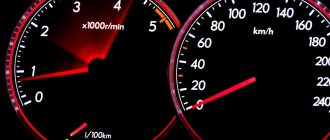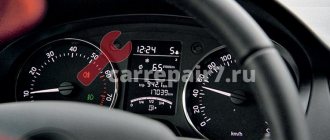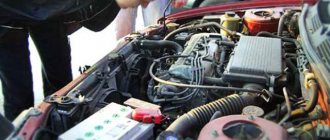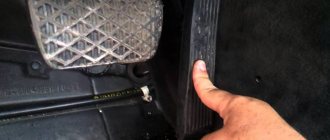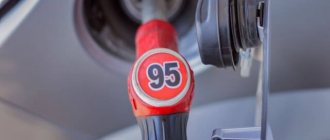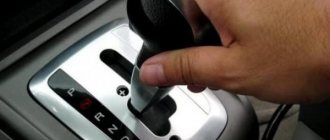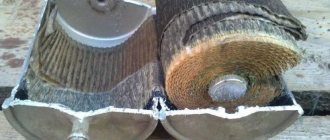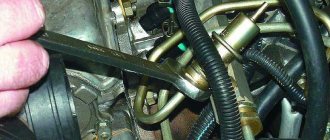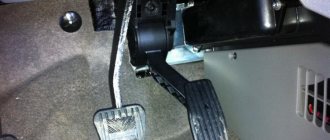Car owners often notice that the car jerks during acceleration when you press the gas pedal. Such dips and jerks mainly appear at low and medium speeds. They are characterized by the following:
- failure from 2 to 9 seconds,
- with a jerk of 1–2 seconds.
Few people like this kind of car behavior. If the car stalls when accelerating, you have to press the pedal harder, which increases fuel consumption. This is also a matter of safety for the driver and passengers. When overtaking, a quick reaction to the gas is required, but the car “thinks and hesitates for a long time,” which is why you may not have time to complete the maneuver. With such thoughtfulness of the gas pedal, the ride becomes uncomfortable.
Why does the car jerk when you gently press the accelerator?
- In this situation, the engine responds late to pressing the gas pedal. Jerking occurs when the throttle valve remains open for a long time. At the time of acceleration, the throttle position sensor (TPS) must send a signal to the electronic control unit (ECU) that the engine is switching from idle to load mode, therefore, more fuel must be supplied to the combustion chambers, and the total pressure in the fuel rail must be high. If the TPS is faulty, it does not send the above signal to the ECU (or it does, but with a delay). As a result, the pressure in the ramp drops, the engine begins to twitch, and sometimes stalls. This malfunction occurs in injection engines, both in domestic cars (Lada Priora, Lada Granta) and in foreign cars (in particular, Ford Focus 2). The solution is obvious: you need to replace the faulty sensor.
- The same problem in fuel-injected cars can be created by the mass air flow sensor (MAF). He monitors the formation of the mixture and how much air enters it. If it is faulty, the car will start to twitch before it has time to accelerate. This means that the mass air flow sensor should also be replaced.
- In carburetor cars (VAZ 2107, the first rare release of the VAZ 2114), jerks during acceleration occur due to clogging of the outlet holes in the first carburetor chamber. Solution: the carburetor is removed and blown out with compressed air.
- In classic VAZ models, carburetor accelerator pumps often fail, and this also causes jerking when trying to move away. It is impractical to repair this part, so it should be replaced.
Air shortage
The air filter is designed to clean the air from road debris, dust and other components that can damage the engine. This element is capable of accumulating dirt to the point of complete obstruction. A clogged filter is the most underrated reason why your car will drive rough due to inefficient fuel combustion.
Another popular reason for a car's abrupt acceleration is the mass air flow sensor. The component performs the task of measuring the amount of intake air and transmitting data to the on-board computer. A defective or dirty sensor causes a loss of engine power and increased fuel consumption.
Oxygen sensors
Most modern car engines are equipped with oxygen sensors (lambda probes). Their number can reach several pieces, depending on the car model. The presence of such a control loop contributes to the smooth and economical operation of the engine. Typically, you can find two types of such sensors:
- Upflow lambda probes. Located inside the exhaust manifold and designed to measure the oxygen level in the vehicle's exhaust gases during the exhaust stroke. Their task is to control incomplete combustion.
- Downflow sensors. Located behind the catalytic converter. They transmit to the computer the information necessary to fine-tune the ratio of fuel and air in the mixture.
Engine jerking while driving
- If, after gaining speed, power dips are observed, then, as a rule, the ignition system is to blame. This problem applies to all types of engines. Solution: turn off the ignition and check whether the block with wires fits tightly to the coil. After this, you need to start the engine again and listen to how it works. If characteristic clicks are heard, it means that a high voltage breakdown has occurred somewhere. Consequently, the block, high-voltage wires (and possibly the coil itself) will have to be changed.
- Another reason for jerking while driving is problems with gasoline. To identify them, remove the spark plugs and inspect them. If they have a white soot on them, similar to talc, it means that due to low-quality gasoline, a lean fuel mixture is entering the combustion chambers. Solution: drain the low-quality gasoline and refuel elsewhere.
A white coating on the spark plugs almost always indicates an unsuitable quality of the fuel mixture.
Electronics
The car may jerk when you step on the gas due to electrical faults. The problem is in the sensors and spark plugs. You need to check other elements as well.
Rarely is the generator causing the jerking. When diagnosing, the node must be tested. If the mains voltage is low, the generator operates intermittently, some parts in the device are worn out. The fuel pump and ignition system will not be able to function normally, even if the mechanisms are working properly.
When a car is equipped with a mechanical distributor, the problem may be hiding there. At high humidity, condensation forms, which falls on the contact groups and into the housing of electronic units. The spark occurs in the distributor, this should not happen.
The problem is the formation of condensation. It is necessary to leave the car in a dry room and check how the engine will work. Condensation is preliminarily removed.
Jerking if you press the trigger sharply
The main reason for this is the “triple” of the engine. That is, a situation when only three of the car’s four cylinders are working. If the engine stalls, it simply does not have time to react in time when you sharply press the gas pedal, and jerking occurs. This problem applies to all types of engines. Here are the main reasons for its occurrence and ways to eliminate it:
- The oxygen sensor is not working properly. Solution: check with a multimeter, replace if faulty.
- The engine's valve timing has shifted. Solution: Adjust according to the vehicle's operating instructions.
- Incorrect spark plug heat rating. Solution: check the heat number in the instructions and install a new set of spark plugs with the correct number.
- The injectors are clogged. Solution: remove them, install them on a stand that simulates engine operation, and wash them with a special solvent.
- In addition, in carburetor cars, jerking when you sharply press the gas may occur due to the fact that the accelerator pump in the carburetor is not working correctly. Solution: the pump is removed, its nozzle is checked, then the diaphragm and valve channels. If they become clogged, they should be thoroughly blown out with compressed air.
Mix preparation unit
Depending on the type of engine, the injector or carburetor is responsible for preparing the mixture. Mechanisms can cause jerking when driving. In the injector, the malfunction is caused by clogged air channels or nozzles, in the carburetor - by the jets.
The units become clogged after refueling with low-quality fuel, when the car has been standing idle for a long time.
To fix the problem, cleaning is required. In the case of a carburetor, you can do the procedure yourself even on the road. Under the hood you need to remove the air filter to gain access to the carburetor. It is necessary to blow out the channels with a pump. It is more convenient to use a compressor; a regular hand or foot compressor will do.
The effect of the procedure does not last long; in emergency cases, this is the only option to get to a service station. It is recommended to completely flush the carburetor with appropriate products. If you have no experience in carrying out such actions, it is better to trust the professionals in the car service.
In the case of an injector, you won’t be able to flush the system yourself; to do this, you need to imitate the operation of the engine, and special equipment is required. You'll have to go to a car service center.
Many people wash the injectors, and the problem goes away for some period. This effect will not last long, the parts will become clogged with dirt again. You need to purchase new injectors and install them to replace the old ones.
The car jerks when you sharply press the gas: why does this happen?
First of all, it should be understood that jerking and jerking when pressing the gas is most often associated with the quality of the fuel-air mixture. The mixture can be lean or enriched.
It is for this reason that the engine crankshaft does not spin up immediately after the driver rarely presses the gas, that is, the response to pressing the pedal occurs untimely, then a jerk occurs and the car accelerates.
- So, jerking when you sharply press the gas pedal occurs due to the fact that the engine reacts to such pressure with a clear delay. In other words, the car jerks when the throttle valve is open for a long time.
In this case, the throttle position sensor normally sends a signal to the ECU that the engine has switched from idle mode or another mode to increased load mode. The control unit “understands” that more fuel needs to be supplied to the combustion chamber, and it is also necessary to increase the fuel pressure in the fuel rail.
It is quite obvious that if the TPS does not work, then the required signal does not arrive at the ECU. The sensor may also give an incorrect signal or send it with a delay. It turns out that after the driver presses the gas, the engine first begins to twitch or even stalls if the speed drops significantly.
- Failure of the mass air flow sensor (mass air flow sensor) also leads to a similar problem. This sensor transmits data to the ECU about how much air is entering the engine.
Based on this data, the unit determines how much fuel to supply to obtain the required fuel-air mixture. If the mass air flow sensor is faulty or transmits incorrect data, the mixture formation is disrupted, the engine jerks when accelerating and sharply pressing the gas pedal.
- Let us add that on models with a carburetor, dips and jerks during acceleration may appear as a result of the fact that the outlet holes in the first carburetor chamber are clogged.
Fuel starvation
Jerking during acceleration can be a sign of problems along any part of the entire fuel supply route from the tank to the engine. The internal combustion engine is sensitive to depressurization of the fuel line and problems of fuel leakage from it. Damage to the fuel line can lead not only to the fact that when you sharply press the gas, the car does not react immediately, but even to a fire or explosion. Therefore, a smart first step in diagnosing fuel starvation is to inspect the area under the car for fuel leaks.
The smell of gasoline in the cabin or trunk should also arouse suspicion.
Checking the filter and tank
The fuel filter is responsible for cleaning gasoline before it enters the injection system. It may be clogged with debris, dirt and other particles from the tank or fuel particles. Usually the filter is attached inside the engine compartment on the main line before the mixture formation system. If there is no certainty regarding the date of its last replacement, then a clogged filter as a possible cause of jerks during acceleration should be considered more carefully. To understand whether this is the problem, you need to:
- Physically inspect the fuel filter. If it is visually obvious that it is dirty, then its obstruction is likely causing a restriction in the flow of fuel to the engine.
- Check for leaks at the joints where the fuel lines are spliced with the filter housing. It is not uncommon for connections to loosen before the system depressurizes.
If these problems are found, the fuel filter should be replaced and the threads on the connections should be tightened.
Then make sure that the leak has stopped and test the engine again. In some cases, the tank ventilation system may become clogged. The problem is invisible when the tank is full, but when it is empty it can manifest itself as failures during acceleration.
Troubleshooting pump problems
The fuel pump in a modern car is most often of a submersible type and runs on an electric drive. Its task is to pump fuel out of the tank and push it through the fuel lines in the desired direction. Opening the throttle valve entails an increase in fuel consumption. Accordingly, the pump in this case increases the pressure to satisfy the engine's gasoline needs.
Problems with the pump can cause jerking when accelerating. As a rule, such symptoms indicate the first signs of wear and tear.
Analyzing and troubleshooting fuel pump problems will require professional diagnostic equipment to scan and interpret error codes. Or you will have to remove the pump and check its operation. If it is suspected of being faulty, a complete replacement is recommended.
Common causes of engine jerking
As a rule, engine malfunctions (engine tripping, misfires, etc.) are often the reason that the power unit does not respond in a timely manner to pressing the gas pedal, after which jerking appears. This problem affects diesel and gasoline engines, injection and carburetor. Among the various elements to be checked, as well as diagnostic methods and techniques, experts highlight many items. Let's focus on the main ones.
- Oxygen sensor, which is checked with a multimeter. If a malfunction is detected, the element needs to be replaced with a new one or a known good one.
- It should also be remembered that the engine's valve timing may be disrupted. In this case, it is necessary to align the timing belt or chain as accurately as possible according to the marks.
- The stability of engine operation is also greatly influenced by the correct selection of spark plugs. To put it simply, candles differ in their heat rating. In cases where this indicator is not suitable for the engine, the spark plugs may be too cold or hot. As a result, ignition problems arise and engine misfire or engine detonation may occur.
- As mentioned above, the cause of jerking may be injection nozzles that need to be cleaned. You can clean the nozzles and wash the injector yourself, but it is recommended to do this on a stand or wash the injector with ultrasound.
- On a car with a carburetor, jerking when you sharply press the gas appears in cases where the carburetor accelerator pump stops working correctly. In this case, the pump must be removed and its nozzle, diaphragm, channels, etc. inspected. If clogged, it must be cleaned.
ECU
As with sensors, the engine control unit itself can also fail. In some cases, such a breakdown leads to the fact that when you press the gas pedal, the car does not gain speed above a certain level. At this moment, the ECU may mistakenly believe that the engine has reached its maximum permissible values on the tachometer, and therefore does not allow it to spin up even more.
In more common cases, a sign of a malfunction of the control unit may be a significant deterioration in the car’s traction, as well as the responsiveness of the gas pedal, when, when trying to accelerate, the car does not immediately respond to the driver’s actions. The following symptoms may also appear:
- A sharp increase and decrease in torque;
- Unexpected jerks and jolts when driving;
- Rough engine operation and a number of other symptoms.
What's the result?
Taking into account the above information, it becomes clear that if the engine jerks during acceleration, it is not always possible to quickly determine the problem. The culprit of the problem can be either simple things (dirty injectors, faulty spark plugs or spark plug wires, bad gasoline, clogged fuel/air filters), or more serious problems.
Additional data and observations from the owner himself make it possible to quickly localize and then efficiently eliminate the problem, both when contacting experienced specialists and as part of independent repairs.
As a result, jerks and dips appear when accelerating, and the car jerks in motion during transitional conditions. Causes and troubleshooting.
The reasons why, after pressing the gas pedal, dips occur and the engine begins to choke. Gas engine failures when switching from gasoline to gas.
The engine twitches at idle: why does this happen? Engine jerking in idle mode, diagnostics of possible malfunctions, recommendations.
What to do if the car accelerates worse, does not pick up speed, or has failures during acceleration. Why the engine does not pull, how to find the reason for the decrease in power.
Auto electrician website. Repair practice, electrical circuits, etc.
Why does the car jerk when accelerating? This is probably the most common question when a car comes in for diagnostics.
What to do when the car jerks? The best thing to do, of course, is to have the engine diagnosed, but some things can be checked and fixed yourself. First of all, determine the nature of the twitching (jerks) when they occur. Do they occur only when the accelerator pedal is sharply pressed (sometimes accompanied by shots into the muffler, or into the intake), or jerks occur at a certain speed, for example, when switching an automatic transmission.
Is the check light on? If it is on, try to read the error using a scanner, for example ELM327, or using self-diagnosis, many cars have a self-diagnosis function.
Causes of overclocking failure
You can determine the reason why the car jerks using diagnostics. Possible problems:
- Malfunction of the fuel supply system;
- Damage to engine temperature and mixture enrichment sensors;
- Errors in the ECU;
- Faulty spark plugs;
- Damage to high-voltage wires or ignition coils;
- Clogged or faulty injectors:
On HBO, the problem may arise due to:
- Faulty HBO control unit;
- There is interference in the harness to which the fuel injectors are connected;
- Gas wiring;
- Bad mass.
Ignition and injection
During normal operation, the spark plug receives an electrical signal from the distributor or electronic injection system and sends a current pulse to the electrodes in a fraction of a second. Thus, the vapors in the combustion chamber are ignited. However, there are many reasons why a spark plug may stop sparking properly.
Such problems can cause uneven engine operation during acceleration.
There are many methods for detecting and eliminating problems with spark plugs, but it is better to carry out diagnostics from specialists. A novice mechanic can do the following:
- Check the wires going to the spark plugs. Sometimes rough running of the engine is caused by damaged, worn or misconnected spark plug wires.
- Replace the suspect spark plug. Throughout its entire service life, it must retain its original appearance. If the spark plug is damaged, covered with oil or carbon deposits, you should contact a professional to further diagnose the causes of this condition.
Another factor why the spark plug does not generate a spark may be a malfunction of the ignition coil. This important component increases the vehicle voltage to 30,000 volts, which is the main condition for the formation of a spark. Coil defects cause misfires, which manifest themselves as jerking of the car.
Another common problem in the ignition system is contamination of the injector nozzles. This is not a very serious defect, but it also needs to be eliminated. It is advisable to clean the injectors on a regular basis to avoid costly replacements.
You can carry out this procedure yourself using a special cleaning kit, which is inexpensive and is always on sale.
How to fix overclocking failures
- Check the ignition wires and coils. When a breakdown occurs, the spark plug wires spark and glow in the dark. The engine shakes and jerks. This happens due to age, poor quality parts or poor contact with the spark plugs. The malfunction may be related to the engine temperature. The interwinding resistance of the coils and the thermal operating conditions change together, which is why a gasoline car jerks during acceleration. If you have a diesel engine, jerks during acceleration are definitely not related to the operation of the coils, they are not there.
- Inspect the spark plugs. Poor contact with the wires, heavy carbon deposits, too lean or rich fuel mixture disable them. Unscrew and check each spark plug as in our article “Diagnostics of internal combustion engine operation using spark plugs,” where we gave examples of faulty spark plugs.
- Check the fuel, oil and air filters. Over time, they become clogged, which leads to deterioration in dynamics, increased fuel consumption and periodic failures. You can replace them yourself; they are inexpensive and easy to install.
If the tips above did not help, only diagnostics will solve the reason for this behavior of the gas pedal. Incorrect operation of systems, errors, composition of the fuel mixture - the diagnostician will name a specific malfunction.
Even if the engine is working properly, the car may move jerkily when accelerating. Motors that meet environmental standards Euro-4 and higher have this unpleasant property. The point is the reaction of the electronic throttle to pressing the gas pedal. It is nonlinear for the first 3–4 centimeters of travel. Because of this, failure may occur during overclocking.
Chip tuning to Euro-2 or Euro-0 standards improves the response of the gas pedal and solves the problem. ECU firmware has a number of other advantages:
- Improves overall dynamics, idle performance and traction at low speeds;
- The car does not stall when the air conditioning is on;
- Gear shifts smoother;
- Fuel consumption is reduced while maintaining driving style.
Video from our partner on how chip tuning copes with failures and “brooding” of the accelerator pedal on Gazelle Next:
Contact ADACT partners in your city for chip tuning. We guarantee a 10-day test drive, money back and replacement if you don't like the firmware.
Simple DIY repair
If it is difficult to find the reason why the car moves jerkily when driving, you should contact a car service center and carry out diagnostics, but before sending the car in for repair, the driver can carry out basic maintenance himself. What you can do with your own hands:
- replace the air and fuel filters;
- clean the engine and attachments from dirt;
- check the condition of high-voltage wires and the ignition module;
- conduct a visual inspection of the engine compartment - there should be no oil leaks, traces of brake fluid or antifreeze;
- Replace the air filter pipe if it is torn.
A dirty engine often causes high-voltage wires to break through to ground. It is convenient to check whether the ignition coil or I/O wires are breaking through in the dark and silence; any sparking becomes clearly visible visually, and you can also hear clicks when a breakdown occurs.
Checking the fuel pump
The main indicator of the performance of the fuel pump is the gasoline pressure in the fuel rail. Methods of connecting to the fuel line:
- using a standard fitting to measure pressure in the rail. This type of power system is installed on VAZ 8-valve internal combustion engines with a fuel return line from the rack to the gas tank. You can connect the pressure gauge through an adapter that screws onto a fitting with an external thread. Inside the fitting there is a spool valve, reminiscent of a bicycle valve, which, when pressed, communicates with the fuel rail and pressure gauge hose. But not all cars have a factory connector for connecting a pressure gauge. And in some cases the adapter itself is more difficult to find than to make a device for direct connection;
- connection contrary to the fuel line. You will need: a pressure gauge with a measurement scale of up to 7 kg/cm², a fuel hose of a suitable diameter, a tee and 2 fittings (“male” and “female” quick-release type) for connecting standard pipes. Such a simple device will allow you to crash into the fuel line, while maintaining the ability to start the engine.
There are a large number of ready-made kits for measuring fuel pressure in the rail on sale. But purchasing it is not practical for one-time use. The high cost is due to the many different fittings and adapters for connecting to the main types of power systems. If you are considering purchasing such a kit, make sure that it has the necessary adapters to connect to your car.
Features of a car with automatic transmission
Jerks that are noticeable when switching to an up or down gear, a violation of the smoothness of the ride, delays in gear engagement, “pecking” - indicate slipping of the transmission, or overheating of the oil. ATF fluid gradually loses its working qualities due to frequent overheating, and therefore does not provide the necessary pressure to open the valves on time. For “boxes” whose control unit is located in the housing, overheating causes damage to this module: the automatic transmission “jerks” and “falls” into emergency mode, or the car refuses to start after parking.
Sometimes it is possible to eliminate shocks when moving by simply resetting the adaptation. If this does not help, you need a qualified assessment of the condition of the oil for the content of impurities, metal shavings, or dust. Presence - indicates severe wear of the mechanical part. Repair and disassembly will be required.
